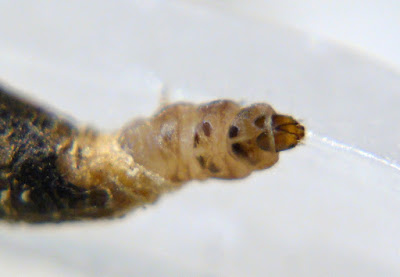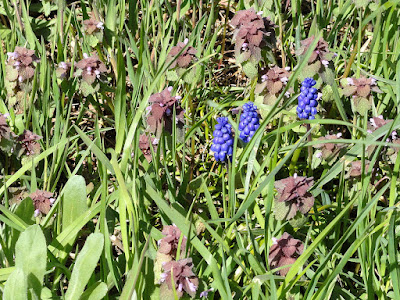Wednesday had been such a bright, summery day, and we'd spent it in traffic and malls. But we got home with maybe half an hour before the sun set and the chill returned, so I dashed across the street to the vacant lot, to get at least a taste of wildness into the day.
It had been raining off and on for days, so the ground was soggy and puddly. The plants, except for a dandelion and two fading daisies, were all dry stems and crumbled brown leaves. Only the goldenrods held some shape. I picked a handful and headed home; the sun had already dropped behind the evergreens to the west, and the wind was cold.
When I spread out the goldenrods at home, two spiders and a black stick that wriggled dropped out.
I posted the tiny jumping spider
yesterday; here is the second:
 |
| Hunting spider, blending in to the shapes and colours of the goldenrod. |
I tried to photograph the spider on the table; she wasn't interested, so I caught her and replaced her on the plants. Then I spent a good part of the evening looking for her. She was so perfectly camouflaged that I could look straight at her and not see her until she moved.
 |
| She's somewhere in here, but I can't see her. A few seconds after I took the photo, there she was, in plain sight. |
 |
| Goldenrod flowerhead, now fluff, and seed with parachute. |
The tiny stick that wriggled was about the size and colour of the seeds. Worse; it was clinging to a bit of the fluff, which made it look even more like a seed. But it was moving, slowly. I brought out the lens.
 |
| Bagworm moth larva, 5mm long, with only head showing. |
It's a bagworm, the second I've seen. (
Dahlica triquetrella, on a wall.) This one doesn't look like the same species, however; the body pattern is different, and instead of sand, it has chosen bits of the goldenrod to make its case.
 |
| Head end. |
Bagworm moths live all or almost all their lives in these cases. Some species are parthenogenic; there are no males, and the females lay their eggs without needing fertilization. These females never leave their cases. Males of other species do, but only to find a female and mate; then they die.
Larvae hatch from eggs inside the mother's case, leave and immediately start building their own case, using materials and patterns specific to their species. The case has two openings; the head end, where the larva stretches out to walk about and to eat, and the tail, which allows the worm to excrete waste materials.
Some cling to walls or stone, where they eat lichen. Some hang from evergreen trees and eat the needles; a large infestation can seriously damage the tree. This one probably eats goldenrod leaves, and it seemed, watching it, that it was also eating the fluffy parachutes of the seeds. The leaves are dry and brown by now, anyhow. When it has eaten enough, it will pupate and wait out the winter in that state.
Making the case out of local material, in this case goldenrod fiber, helps to protect the moth by making it blend in to the background. Once I had replaced the bagworm on top of the goldenrod, and looked to see how it was managing, I couldn't see it at all.
I shook out a lot of the fluff and examined it, shaking it and blowing it about for a while, until I found a second larva.
 |
| 4mm. Much more timid; by the time I'd brushed the seeds away from it, it had retreated into the case and refused to come out. |
One last critter showed up in the pile of sorted fluff; a small ladybug, the eleven-spotted lady beetle, seemingly dormant. When I moistened the cloth she stood on, she woke, took a drink, groomed herself, struggled past the clinging seeds, and flew away.
 |
| Coccinella unidecimpuntata, 5 mm. long. Not camouflaged at all. |


























